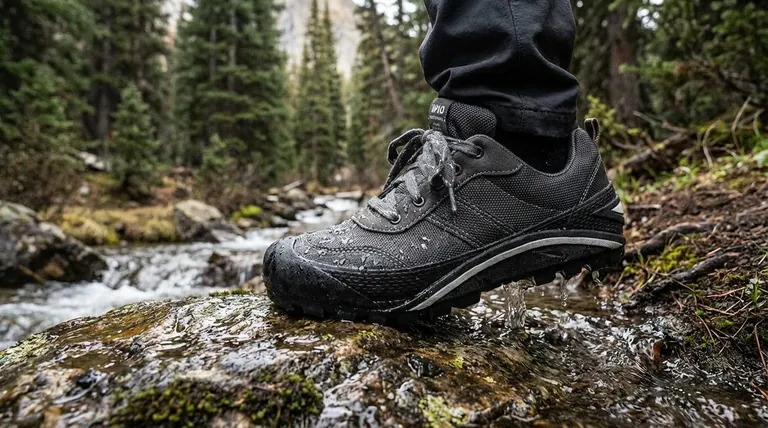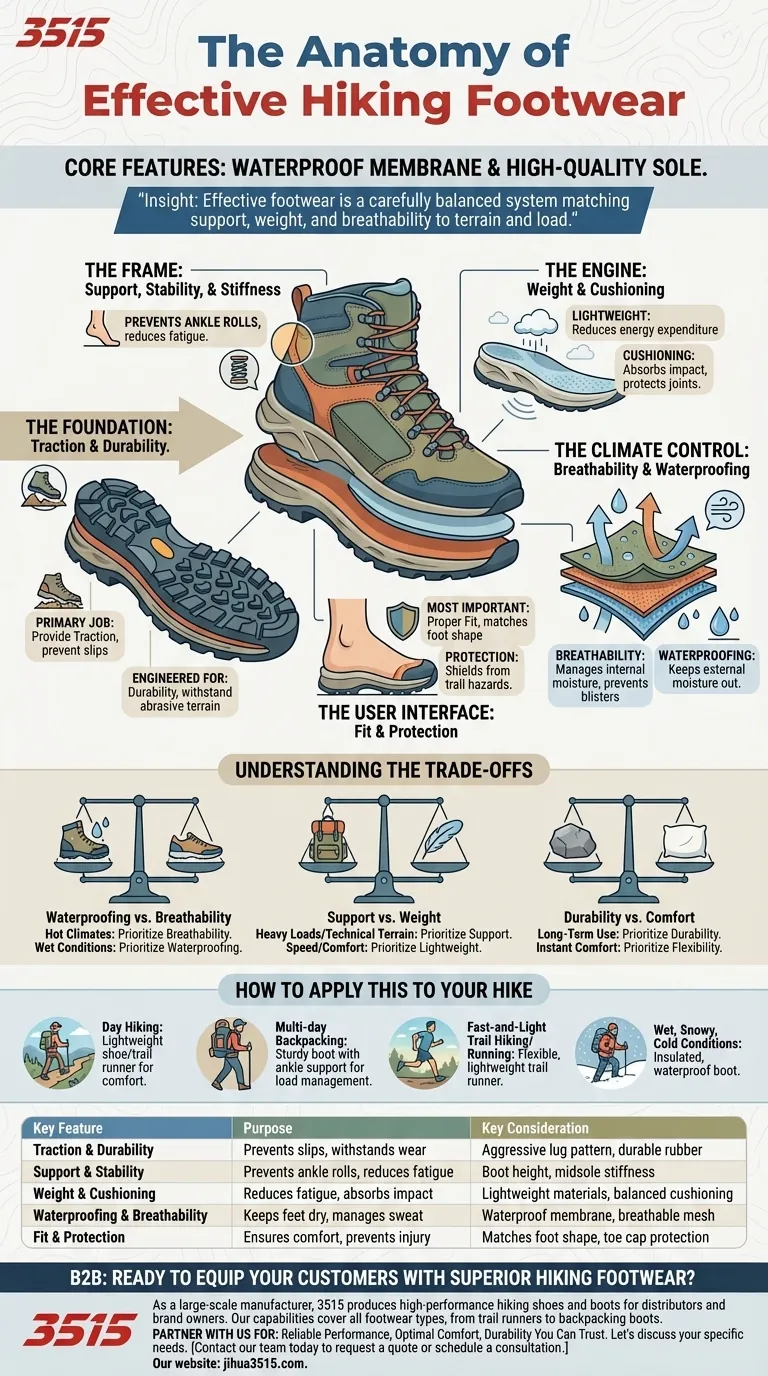At their core, all quality hiking footwear shares two fundamental features: they are built with waterproof membranes to keep your feet dry and high-quality soles to provide reliable traction. These elements form the baseline for any serious hiking shoe, boot, or trail runner.
The most critical insight is that effective hiking footwear is more than a list of features. It is a carefully balanced system where elements like support, weight, and breathability are matched to the specific demands of the terrain, the weight you carry, and your personal foot mechanics.

The Anatomy of Effective Hiking Footwear
Understanding the purpose behind each key feature allows you to move beyond marketing terms and select footwear that truly serves your needs on the trail.
The Foundation: Traction and Durability
The sole of your footwear is your direct connection to the trail. Its primary job is to provide traction, preventing slips and falls on varied surfaces like mud, rock, and loose gravel.
A high-quality sole is also engineered for durability, ensuring it can withstand hundreds of miles of abrasive terrain without significant wear.
The Frame: Support, Stability, and Stiffness
Support and stability are crucial for preventing ankle rolls and reducing fatigue, especially on uneven ground or when carrying a heavy pack.
This is often determined by the footwear's stiffness and cut. Taller hiking boots provide maximum ankle support, while lower-cut hiking shoes and trail runners offer more flexibility at the cost of some stability.
The Engine: Weight and Cushioning
Every ounce on your feet is magnified over thousands of steps. A lightweight design is a key feature that directly reduces energy expenditure and fatigue over a long day.
Cushioning in the midsole absorbs impact, enhancing comfort and protecting your joints. The ideal amount of cushioning is a balance between comfort and feeling connected to the trail.
The Climate Control: Breathability and Waterproofing
While a waterproof membrane is standard for keeping external moisture out, breathability is just as important for managing internal moisture.
Effective footwear allows sweat vapor to escape. This moisture management is critical for preventing the blisters and discomfort that can arise from damp feet, especially on multi-day treks.
The User Interface: Fit and Protection
Ultimately, the most important feature is a proper fit. No amount of technology can compensate for a shoe that doesn't match the shape of your foot, which will inevitably lead to discomfort and blisters.
Good hiking footwear also provides protection, shielding your feet from rocks, roots, and other trail hazards that could cause cuts or bruising.
Understanding the Trade-offs
There is no single "best" hiking shoe because every design choice involves a trade-off. Recognizing these compromises is the key to making an intelligent decision.
Waterproofing vs. Breathability
A highly waterproof boot is excellent for crossing streams but can feel hot and trap sweat in warm, dry climates. In such conditions, a more breathable, non-waterproof shoe that dries quickly might be a better choice.
Support vs. Weight
A heavy, stiff boot offers maximum ankle support, making it ideal for carrying a heavy backpack over technical terrain. However, that same boot requires significantly more energy to lift with every step compared to a lightweight trail runner.
Durability vs. Comfort
The most durable boots are often made from tough, stiff materials that may require a "break-in" period to become comfortable. In contrast, softer, more flexible shoes often feel great out of the box but may wear out more quickly.
How to Apply This to Your Hike
Your choice should be dictated by your intended use, not just a list of features.
- If your primary focus is day hiking on well-maintained trails: Prioritize a lightweight hiking shoe or trail runner for all-day comfort and energy savings.
- If your primary focus is multi-day backpacking with a heavy pack: Choose a sturdy hiking boot with excellent ankle support to manage the load and prevent injury on rough terrain.
- If your primary focus is fast-and-light trail hiking or running: Select a trail runner that offers maximum flexibility, minimal weight, and aggressive traction.
- If your primary focus is hiking in wet, snowy, or cold conditions: Look for an insulated, waterproof boot to ensure your feet remain warm and dry.
The right hiking footwear is the pair that allows you to forget you're wearing it and focus completely on the experience of the trail.
Summary Table:
| Key Feature | Purpose | Key Consideration |
|---|---|---|
| Traction & Durability | Prevents slips, withstands wear | Aggressive lug pattern, durable rubber compound |
| Support & Stability | Prevents ankle rolls, reduces fatigue | Boot height (high-cut vs. low-cut), midsole stiffness |
| Weight & Cushioning | Reduces fatigue, absorbs impact | Lightweight materials, balanced cushioning |
| Waterproofing & Breathability | Keeps feet dry, manages sweat | Waterproof membrane (e.g., GORE-TEX), breathable mesh |
| Fit & Protection | Ensures comfort, prevents injury | Matches foot shape, toe cap protection |
Ready to Equip Your Customers with Superior Hiking Footwear?
As a large-scale manufacturer, 3515 produces a comprehensive range of high-performance hiking shoes and boots for distributors, brand owners, and bulk clients. Our production capabilities encompass all types of footwear, from lightweight trail runners to durable backpacking boots, ensuring you get the perfect product for your market.
Partner with us to offer your customers:
- Reliable Performance: Footwear built with proven waterproof membranes and high-traction soles.
- Optimal Comfort: Designs focused on fit, cushioning, and breathability for all-day wear.
- Durability You Can Trust: Products engineered to withstand the demands of the trail.
Let's discuss your specific needs and how we can support your business.
Contact our team today to request a quote or schedule a consultation.
Visual Guide

Related Products
- Durable Rubber Sole Outdoor Shoes Wholesale & Custom Manufacturing
- Durable Waterproof Rain Boots | Custom Manufacturer for Wholesale & Brands
- Safety Footwear Wholesale Manufacturer for Custom OEM/ODM Production
- Premium Suede Sport Safety Shoes for Wholesale & Bulk Orders
- Advanced KPU Athletic Safety Shoe with Steel Toe Cap Anti-Slip Rotary Lacing System
People Also Ask
- Why are vulcanized soles popular in urban fashion? Discover the Legacy of Authentic Street Style
- What were traditional shoe soles made from before rubber? The History of Leather Soles
- What are the disadvantages of vulcanized soles? Lack of Support & Durability Explained
- What are some alternatives to hunting boots? Hiking, Rubber & Tactical Boots Explained
- How does cushioning work in hiking shoes? The Science of Shock Absorption



















